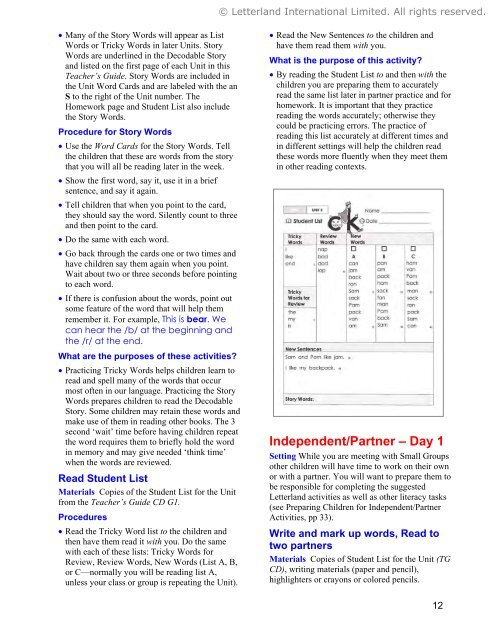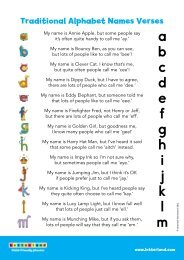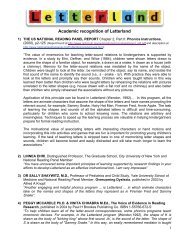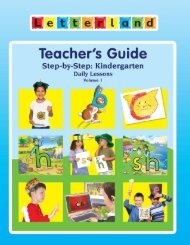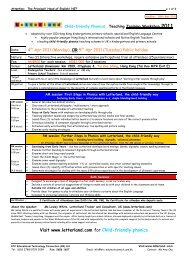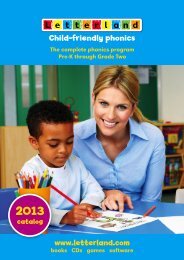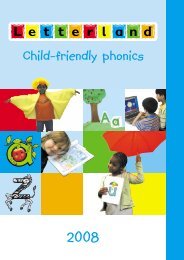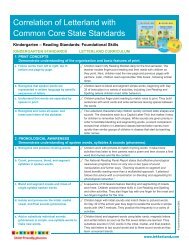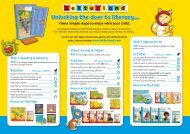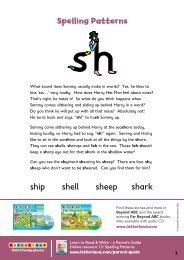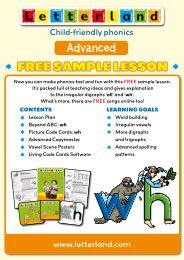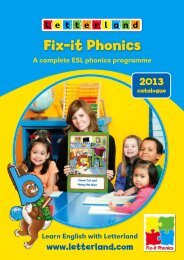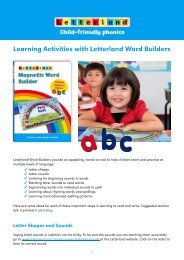Teacher's Guide - Letterland
Teacher's Guide - Letterland
Teacher's Guide - Letterland
You also want an ePaper? Increase the reach of your titles
YUMPU automatically turns print PDFs into web optimized ePapers that Google loves.
© <strong>Letterland</strong> International Limited. All rights reserved.• Many of the Story Words will appear as ListWords or Tricky Words in later Units. StoryWords are underlined in the Decodable Storyand listed on the first page of each Unit in thisTeacher’s <strong>Guide</strong>. Story Words are included inthe Unit Word Cards and are labeled with the anS to the right of the Unit number. TheHomework page and Student List also includethe Story Words.Procedure for Story Words• Use the Word Cards for the Story Words. Tellthe children that these are words from the storythat you will all be reading later in the week.• Show the first word, say it, use it in a briefsentence, and say it again.• Tell children that when you point to the card,they should say the word. Silently count to threeand then point to the card.• Do the same with each word.• Go back through the cards one or two times andhave children say them again when you point.Wait about two or three seconds before pointingto each word.• If there is confusion about the words, point outsome feature of the word that will help themremember it. For example, This is bear. Wecan hear the /b/ at the beginning andthe /r/ at the end.What are the purposes of these activities?• Practicing Tricky Words helps children learn toread and spell many of the words that occurmost often in our language. Practicing the StoryWords prepares children to read the DecodableStory. Some children may retain these words andmake use of them in reading other books. The 3second ‘wait’ time before having children repeatthe word requires them to briefly hold the wordin memory and may give needed ‘think time’when the words are reviewed.Read Student ListMaterials Copies of the Student List for the Unitfrom the Teacher’s <strong>Guide</strong> CD G1.Procedures• Read the Tricky Word list to the children andthen have them read it with you. Do the samewith each of these lists: Tricky Words forReview, Review Words, New Words (List A, B,or C—normally you will be reading list A,unless your class or group is repeating the Unit).• Read the New Sentences to the children andhave them read them with you.What is the purpose of this activity?• By reading the Student List to and then with thechildren you are preparing them to accuratelyread the same list later in partner practice and forhomework. It is important that they practicereading the words accurately; otherwise theycould be practicing errors. The practice ofreading this list accurately at different times andin different settings will help the children readthese words more fluently when they meet themin other reading contexts.Independent/Partner – Day 1Setting While you are meeting with Small Groupsother children will have time to work on their ownor with a partner. You will want to prepare them tobe responsible for completing the suggested<strong>Letterland</strong> activities as well as other literacy tasks(see Preparing Children for Independent/PartnerActivities, pp 33).Write and mark up words, Read totwo partnersMaterials Copies of Student List for the Unit (TGCD), writing materials (paper and pencil),highlighters or crayons or colored pencils.12


